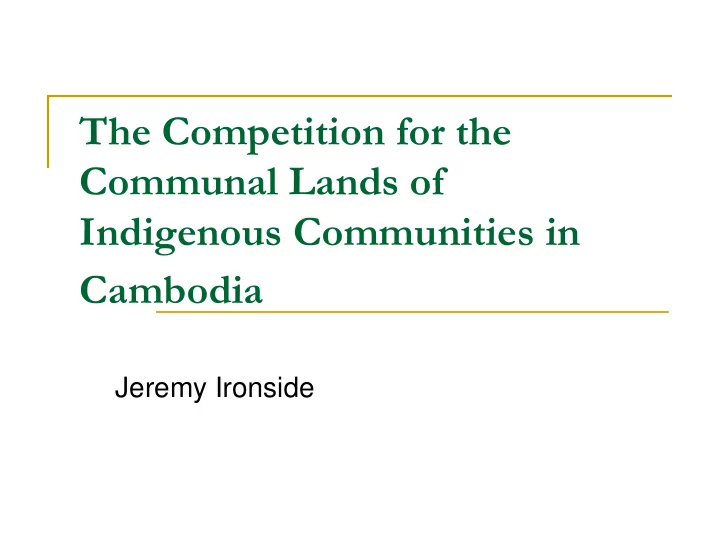

The Competition for the Communal Lands of Indigenous Communities in Cambodia Jeremy Ironside
Ratanakiri and Mondulkiri Provinces. 2008 census - 179,215 indigenous people, or 1.4 per cent of the population. The only 2 provinces where indigenous peoples are the majority. Ratanakiri - 10,782 km², population - 150,000 = 14 people/km² Mondulkiri - 14,682 km², population - 60,811 = 14 people/km² Annual population growth rates of 4.65% (Ratanakiri) and 6.29% (Mondulkiri). Highest poverty rates in the country.
Background: Baseline Post independence (1960s) continued and expanded colonialist policies, International and civil war - continued in remote areas until 1998, War and remoteness allowed indigenous groups to avoid large scale deculturation but also left them unprepared for ‘modernisation’ processes, CLV Development Triangle.
Alienation of Communal Land in Cambodia 1) Traditional system 2) Early Land Sales (1990s) 3) Post 2001 Land Law Illegal Land Sales Communal Forest areas 4) The Future ?
Small scale dispossession Reasons Accessibility, Insecure tenure – denial of customary rights, Disputed boundaries, Active involvement of local authorities – accepting bribes and as land brokers, Desire for money, No recourse through the judicial system, Men invariably are the ones at least initiating the sale of their families’ lands.
Small v Large scale dispossession – what is land grabbing? Small scale closely linked to larger concessions because; Sell now or you will lose your land anyway, Free market policies driven by IFIs provided the alienation infrastructure which larger companies could use – collusion by authorities, use of intimidation and fraud, under valued land, etc. Large scale land grabs are simply the culmination of historical processes by which land has always been grabbed.
Concessions 1,325,724ha to 128 companies – not counting concessions granted inside protected areas and provincial concessions. 2005 Economic Land Concession Sub Decree is ignored – widespread speculation and clearing for logs. Land dealers who told villagers they should sell before the state takes their land off them, were right. Long term crops are interpreted as land individualization.
Burial and spirit forests Desecration of burial and spirit forest areas touches at the heart of indigenous culture and symbolizes the clash of cultures in play.
Communal Land Titling 2001 Land Law Chapter 3 – Collective Ownership: Immovable Property of Indigenous Communities Article 23: ‘…the groups actually existing at present shall continue to manage their community and immovable property according to their traditional customs…’ Article 25: ‘… not only lands actually cultivated but also includes reserved areas necessary for the shifting of cultivation…’ Article 26: ‘… includes all of the rights and protections of ownership as are enjoyed by private owners…’
Communal Land Titling Three pilot communal land titles – in 2011? Another 17 villages with legal entity recognition, Seen as bringing communities ‘under the law’, Door has been opened for a significant scaling up, Reluctance by government to implement protective measures and view communal land titling as a temporary bridge, Some evidence that LE registration has provided some security. ‘cooked but we haven't eaten it yet'
Communal Land Titling Why community members want a communal title follows traditions, to protect resources fear that individual titles will mean they will lose their land, Key issue is what is the appropriate level of decision making. Appears to be more appropriate for encouraging diverse land use A lot of discussion about adaptive strategies for agriculture to deal with climate change. However systems on which that adaptation could be built continue to be destroyed.
Conclusion Cambodia today false development; main motivation for land grabbing, is to occupy and control resources, New land led patronage system is being created, Similarities of small and large scale alienation, Both are related to policies favouring industrial agricultural production. Public opinion is either ignorant or accepts the logic of this land use.
Conclusion Important to support communal land management systems as a potential alternative to the concentration of land and wealth, and inevitably industrial models of agriculture from land privatization. Henry George in 1879 '…as the value of land increases, so does the contrast between wealth and want ….' George (1905; 224). Speculatory locking away land 'condemn(s) the producer of wealth to poverty … pamper(s) the non -producer in luxury, … rear(s) the tenement house with the palace, plant(s) the brothel behind the church, and compel(s) us to build prisons as we open new schools (George, 1905; 340).
Thank you
Recommend
More recommend